MBA Marketing Management Report: Analyzing Domino's Pizza Strategies
VerifiedAdded on 2022/08/26
|20
|5924
|34
Report
AI Summary
This report provides a comprehensive marketing analysis of Domino's Pizza. It begins with an introduction to marketing and the application of Porter's Five Forces model, followed by an examination of PESTLE factors, including political, economic, social, technological, legal, and environmental influences on the company. The report then applies Porter's Five Forces model to assess the competitive landscape, analyzing the threats of new entrants, bargaining power of buyers and suppliers, threat of substitute products, and competitive rivalry. A detailed SWOT analysis highlights Domino's strengths, weaknesses, opportunities, and threats. The report further explores segmentation, targeting, and positioning strategies, along with a discussion of the marketing mix, including product, pricing, placement, and promotion strategies, including SEO, social media, and email marketing. The report concludes with recommendations for future marketing strategies and a list of references.
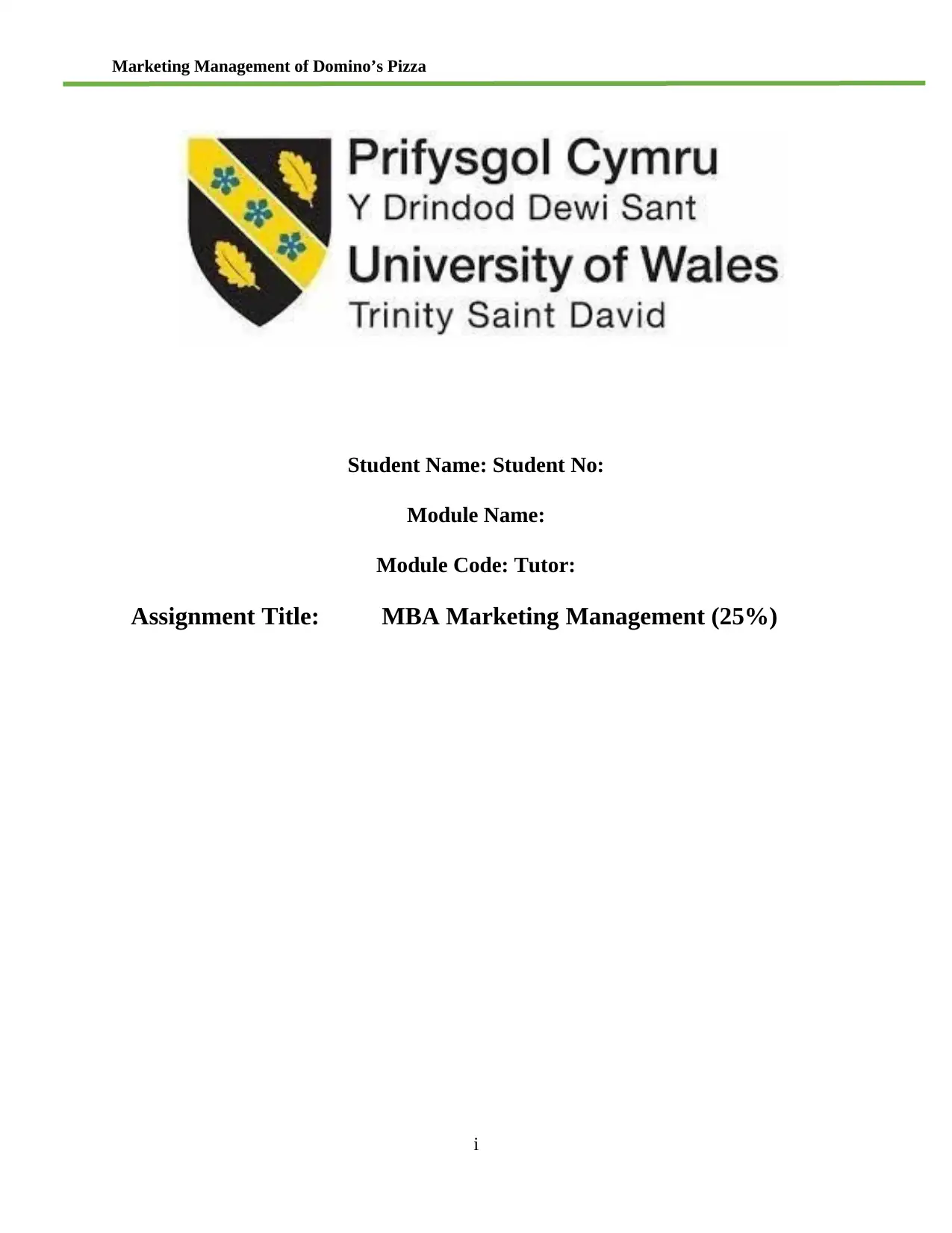
Marketing Management of Domino’s Pizza
Student Name: Student No:
Module Name:
Module Code: Tutor:
Assignment Title: MBA Marketing Management (25%)
i
Student Name: Student No:
Module Name:
Module Code: Tutor:
Assignment Title: MBA Marketing Management (25%)
i
Paraphrase This Document
Need a fresh take? Get an instant paraphrase of this document with our AI Paraphraser
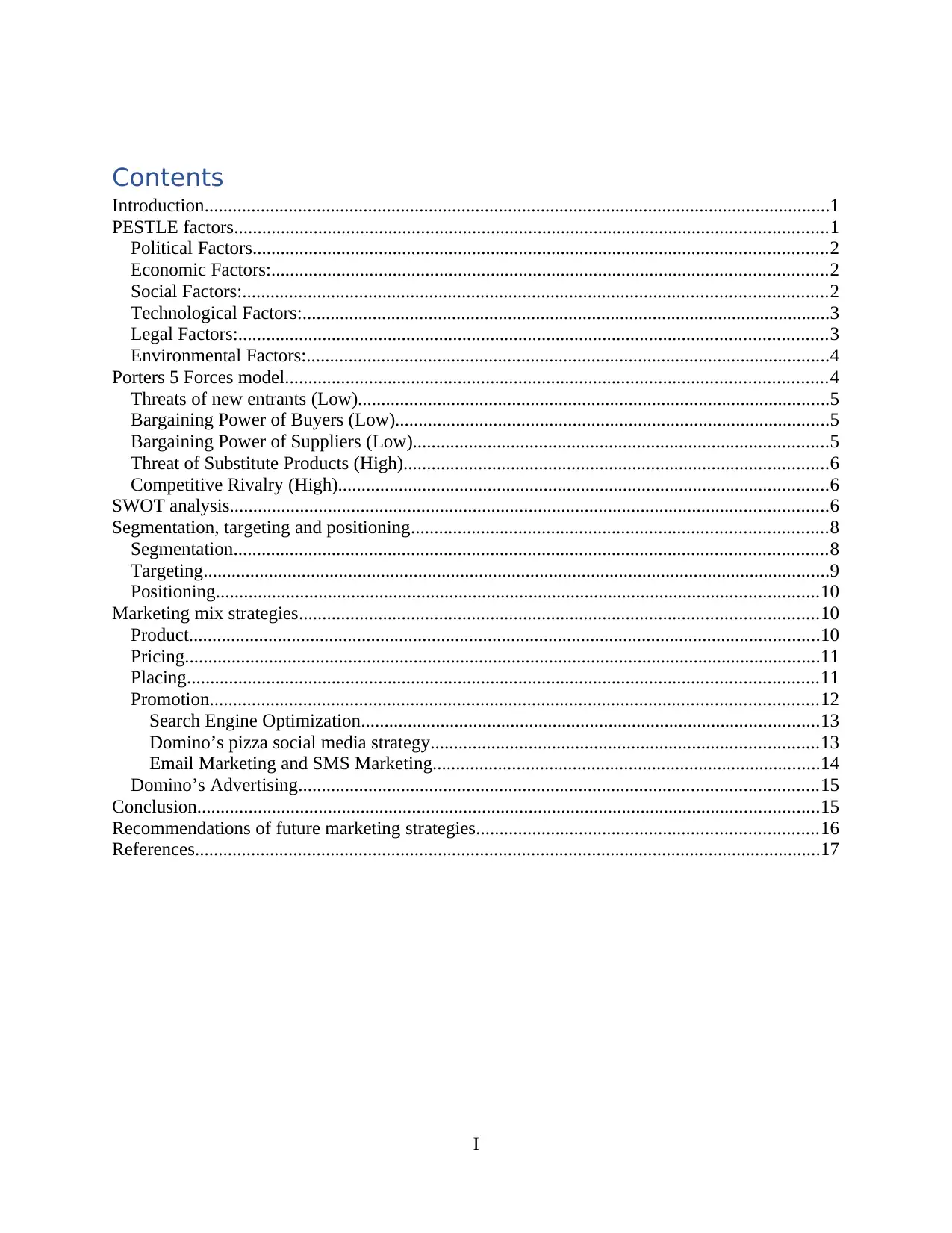
Contents
Introduction......................................................................................................................................1
PESTLE factors...............................................................................................................................1
Political Factors...........................................................................................................................2
Economic Factors:.......................................................................................................................2
Social Factors:.............................................................................................................................2
Technological Factors:.................................................................................................................3
Legal Factors:..............................................................................................................................3
Environmental Factors:................................................................................................................4
Porters 5 Forces model....................................................................................................................4
Threats of new entrants (Low).....................................................................................................5
Bargaining Power of Buyers (Low).............................................................................................5
Bargaining Power of Suppliers (Low).........................................................................................5
Threat of Substitute Products (High)...........................................................................................6
Competitive Rivalry (High).........................................................................................................6
SWOT analysis................................................................................................................................6
Segmentation, targeting and positioning.........................................................................................8
Segmentation...............................................................................................................................8
Targeting......................................................................................................................................9
Positioning.................................................................................................................................10
Marketing mix strategies...............................................................................................................10
Product.......................................................................................................................................10
Pricing........................................................................................................................................11
Placing.......................................................................................................................................11
Promotion..................................................................................................................................12
Search Engine Optimization..................................................................................................13
Domino’s pizza social media strategy...................................................................................13
Email Marketing and SMS Marketing...................................................................................14
Domino’s Advertising...............................................................................................................15
Conclusion.....................................................................................................................................15
Recommendations of future marketing strategies.........................................................................16
References......................................................................................................................................17
I
Introduction......................................................................................................................................1
PESTLE factors...............................................................................................................................1
Political Factors...........................................................................................................................2
Economic Factors:.......................................................................................................................2
Social Factors:.............................................................................................................................2
Technological Factors:.................................................................................................................3
Legal Factors:..............................................................................................................................3
Environmental Factors:................................................................................................................4
Porters 5 Forces model....................................................................................................................4
Threats of new entrants (Low).....................................................................................................5
Bargaining Power of Buyers (Low).............................................................................................5
Bargaining Power of Suppliers (Low).........................................................................................5
Threat of Substitute Products (High)...........................................................................................6
Competitive Rivalry (High).........................................................................................................6
SWOT analysis................................................................................................................................6
Segmentation, targeting and positioning.........................................................................................8
Segmentation...............................................................................................................................8
Targeting......................................................................................................................................9
Positioning.................................................................................................................................10
Marketing mix strategies...............................................................................................................10
Product.......................................................................................................................................10
Pricing........................................................................................................................................11
Placing.......................................................................................................................................11
Promotion..................................................................................................................................12
Search Engine Optimization..................................................................................................13
Domino’s pizza social media strategy...................................................................................13
Email Marketing and SMS Marketing...................................................................................14
Domino’s Advertising...............................................................................................................15
Conclusion.....................................................................................................................................15
Recommendations of future marketing strategies.........................................................................16
References......................................................................................................................................17
I
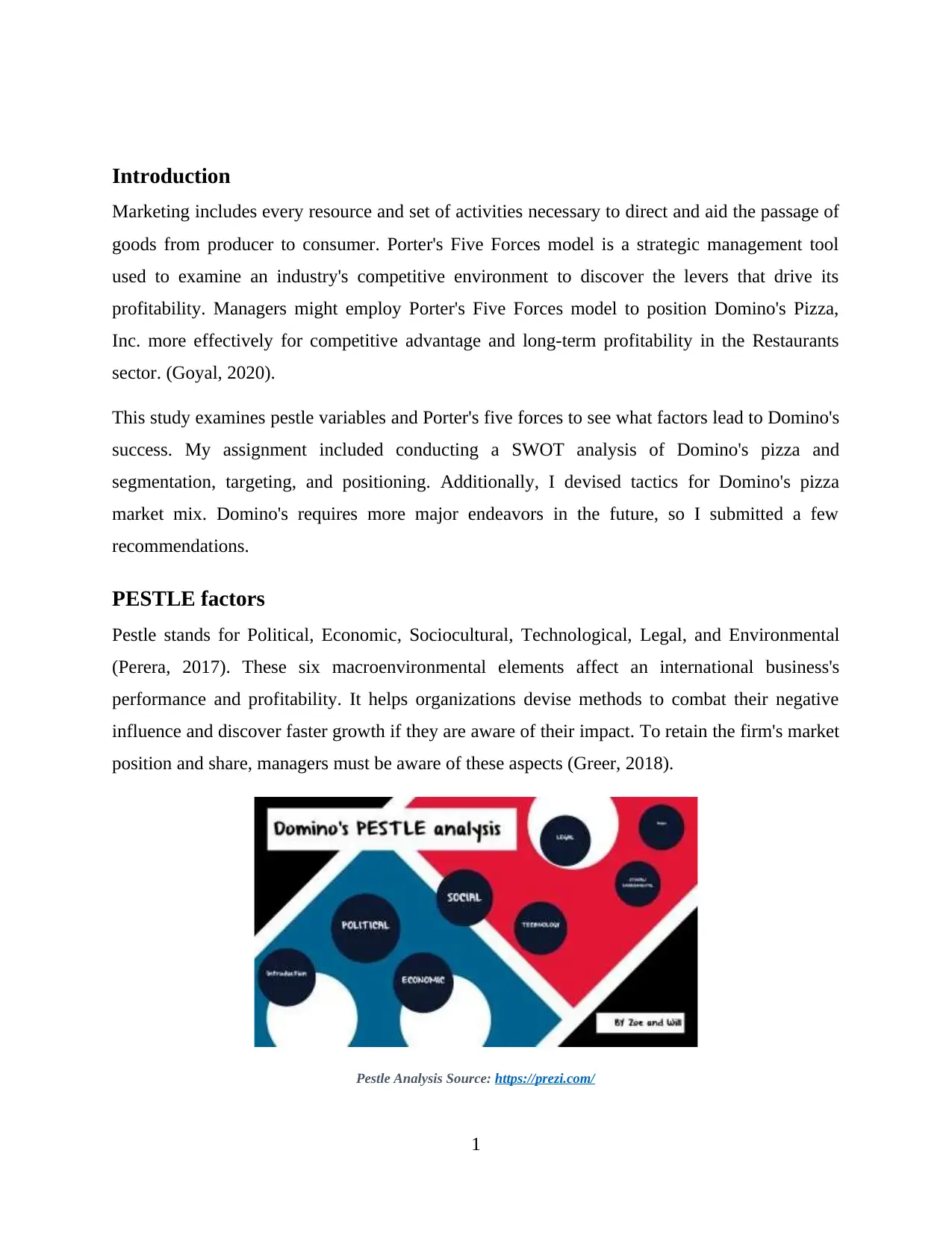
Introduction
Marketing includes every resource and set of activities necessary to direct and aid the passage of
goods from producer to consumer. Porter's Five Forces model is a strategic management tool
used to examine an industry's competitive environment to discover the levers that drive its
profitability. Managers might employ Porter's Five Forces model to position Domino's Pizza,
Inc. more effectively for competitive advantage and long-term profitability in the Restaurants
sector. (Goyal, 2020).
This study examines pestle variables and Porter's five forces to see what factors lead to Domino's
success. My assignment included conducting a SWOT analysis of Domino's pizza and
segmentation, targeting, and positioning. Additionally, I devised tactics for Domino's pizza
market mix. Domino's requires more major endeavors in the future, so I submitted a few
recommendations.
PESTLE factors
Pestle stands for Political, Economic, Sociocultural, Technological, Legal, and Environmental
(Perera, 2017). These six macroenvironmental elements affect an international business's
performance and profitability. It helps organizations devise methods to combat their negative
influence and discover faster growth if they are aware of their impact. To retain the firm's market
position and share, managers must be aware of these aspects (Greer, 2018).
Pestle Analysis Source: https://prezi.com/
1
Marketing includes every resource and set of activities necessary to direct and aid the passage of
goods from producer to consumer. Porter's Five Forces model is a strategic management tool
used to examine an industry's competitive environment to discover the levers that drive its
profitability. Managers might employ Porter's Five Forces model to position Domino's Pizza,
Inc. more effectively for competitive advantage and long-term profitability in the Restaurants
sector. (Goyal, 2020).
This study examines pestle variables and Porter's five forces to see what factors lead to Domino's
success. My assignment included conducting a SWOT analysis of Domino's pizza and
segmentation, targeting, and positioning. Additionally, I devised tactics for Domino's pizza
market mix. Domino's requires more major endeavors in the future, so I submitted a few
recommendations.
PESTLE factors
Pestle stands for Political, Economic, Sociocultural, Technological, Legal, and Environmental
(Perera, 2017). These six macroenvironmental elements affect an international business's
performance and profitability. It helps organizations devise methods to combat their negative
influence and discover faster growth if they are aware of their impact. To retain the firm's market
position and share, managers must be aware of these aspects (Greer, 2018).
Pestle Analysis Source: https://prezi.com/
1
⊘ This is a preview!⊘
Do you want full access?
Subscribe today to unlock all pages.

Trusted by 1+ million students worldwide
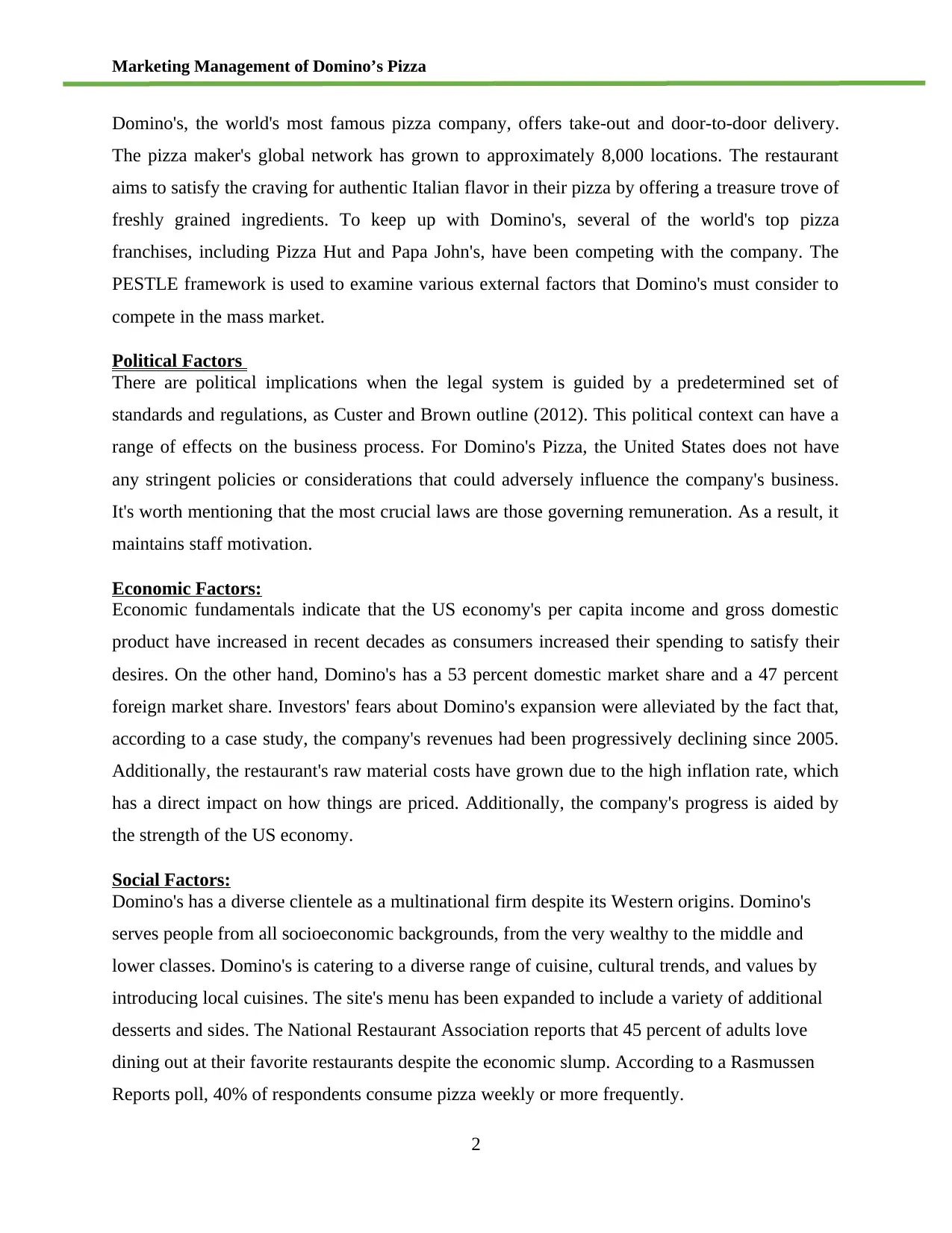
Marketing Management of Domino’s Pizza
Domino's, the world's most famous pizza company, offers take-out and door-to-door delivery.
The pizza maker's global network has grown to approximately 8,000 locations. The restaurant
aims to satisfy the craving for authentic Italian flavor in their pizza by offering a treasure trove of
freshly grained ingredients. To keep up with Domino's, several of the world's top pizza
franchises, including Pizza Hut and Papa John's, have been competing with the company. The
PESTLE framework is used to examine various external factors that Domino's must consider to
compete in the mass market.
Political Factors
There are political implications when the legal system is guided by a predetermined set of
standards and regulations, as Custer and Brown outline (2012). This political context can have a
range of effects on the business process. For Domino's Pizza, the United States does not have
any stringent policies or considerations that could adversely influence the company's business.
It's worth mentioning that the most crucial laws are those governing remuneration. As a result, it
maintains staff motivation.
Economic Factors:
Economic fundamentals indicate that the US economy's per capita income and gross domestic
product have increased in recent decades as consumers increased their spending to satisfy their
desires. On the other hand, Domino's has a 53 percent domestic market share and a 47 percent
foreign market share. Investors' fears about Domino's expansion were alleviated by the fact that,
according to a case study, the company's revenues had been progressively declining since 2005.
Additionally, the restaurant's raw material costs have grown due to the high inflation rate, which
has a direct impact on how things are priced. Additionally, the company's progress is aided by
the strength of the US economy.
Social Factors:
Domino's has a diverse clientele as a multinational firm despite its Western origins. Domino's
serves people from all socioeconomic backgrounds, from the very wealthy to the middle and
lower classes. Domino's is catering to a diverse range of cuisine, cultural trends, and values by
introducing local cuisines. The site's menu has been expanded to include a variety of additional
desserts and sides. The National Restaurant Association reports that 45 percent of adults love
dining out at their favorite restaurants despite the economic slump. According to a Rasmussen
Reports poll, 40% of respondents consume pizza weekly or more frequently.
2
Domino's, the world's most famous pizza company, offers take-out and door-to-door delivery.
The pizza maker's global network has grown to approximately 8,000 locations. The restaurant
aims to satisfy the craving for authentic Italian flavor in their pizza by offering a treasure trove of
freshly grained ingredients. To keep up with Domino's, several of the world's top pizza
franchises, including Pizza Hut and Papa John's, have been competing with the company. The
PESTLE framework is used to examine various external factors that Domino's must consider to
compete in the mass market.
Political Factors
There are political implications when the legal system is guided by a predetermined set of
standards and regulations, as Custer and Brown outline (2012). This political context can have a
range of effects on the business process. For Domino's Pizza, the United States does not have
any stringent policies or considerations that could adversely influence the company's business.
It's worth mentioning that the most crucial laws are those governing remuneration. As a result, it
maintains staff motivation.
Economic Factors:
Economic fundamentals indicate that the US economy's per capita income and gross domestic
product have increased in recent decades as consumers increased their spending to satisfy their
desires. On the other hand, Domino's has a 53 percent domestic market share and a 47 percent
foreign market share. Investors' fears about Domino's expansion were alleviated by the fact that,
according to a case study, the company's revenues had been progressively declining since 2005.
Additionally, the restaurant's raw material costs have grown due to the high inflation rate, which
has a direct impact on how things are priced. Additionally, the company's progress is aided by
the strength of the US economy.
Social Factors:
Domino's has a diverse clientele as a multinational firm despite its Western origins. Domino's
serves people from all socioeconomic backgrounds, from the very wealthy to the middle and
lower classes. Domino's is catering to a diverse range of cuisine, cultural trends, and values by
introducing local cuisines. The site's menu has been expanded to include a variety of additional
desserts and sides. The National Restaurant Association reports that 45 percent of adults love
dining out at their favorite restaurants despite the economic slump. According to a Rasmussen
Reports poll, 40% of respondents consume pizza weekly or more frequently.
2
Paraphrase This Document
Need a fresh take? Get an instant paraphrase of this document with our AI Paraphraser
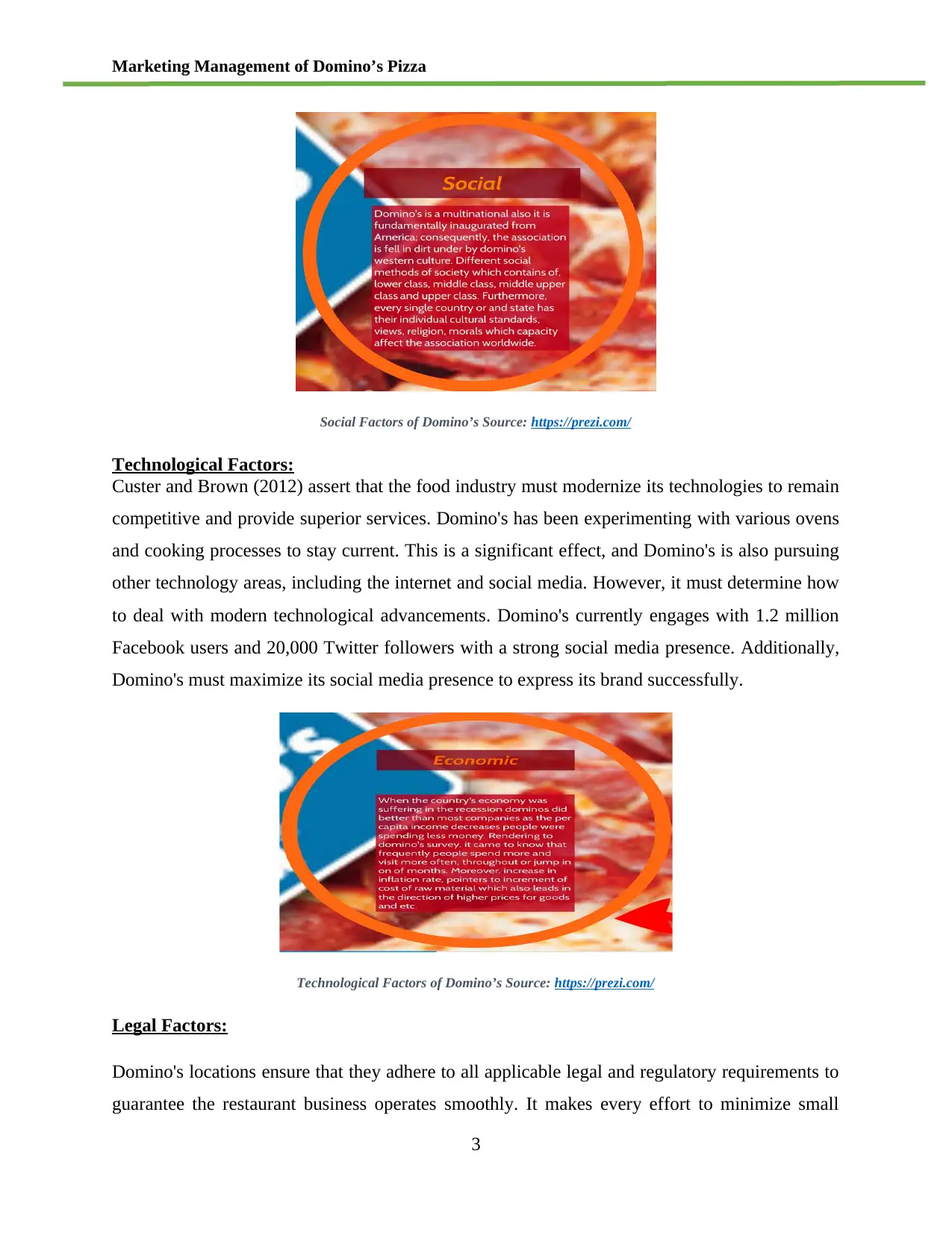
Marketing Management of Domino’s Pizza
Social Factors of Domino’s Source: https://prezi.com/
Technological Factors:
Custer and Brown (2012) assert that the food industry must modernize its technologies to remain
competitive and provide superior services. Domino's has been experimenting with various ovens
and cooking processes to stay current. This is a significant effect, and Domino's is also pursuing
other technology areas, including the internet and social media. However, it must determine how
to deal with modern technological advancements. Domino's currently engages with 1.2 million
Facebook users and 20,000 Twitter followers with a strong social media presence. Additionally,
Domino's must maximize its social media presence to express its brand successfully.
Technological Factors of Domino’s Source: https://prezi.com/
Legal Factors:
Domino's locations ensure that they adhere to all applicable legal and regulatory requirements to
guarantee the restaurant business operates smoothly. It makes every effort to minimize small
3
Social Factors of Domino’s Source: https://prezi.com/
Technological Factors:
Custer and Brown (2012) assert that the food industry must modernize its technologies to remain
competitive and provide superior services. Domino's has been experimenting with various ovens
and cooking processes to stay current. This is a significant effect, and Domino's is also pursuing
other technology areas, including the internet and social media. However, it must determine how
to deal with modern technological advancements. Domino's currently engages with 1.2 million
Facebook users and 20,000 Twitter followers with a strong social media presence. Additionally,
Domino's must maximize its social media presence to express its brand successfully.
Technological Factors of Domino’s Source: https://prezi.com/
Legal Factors:
Domino's locations ensure that they adhere to all applicable legal and regulatory requirements to
guarantee the restaurant business operates smoothly. It makes every effort to minimize small
3
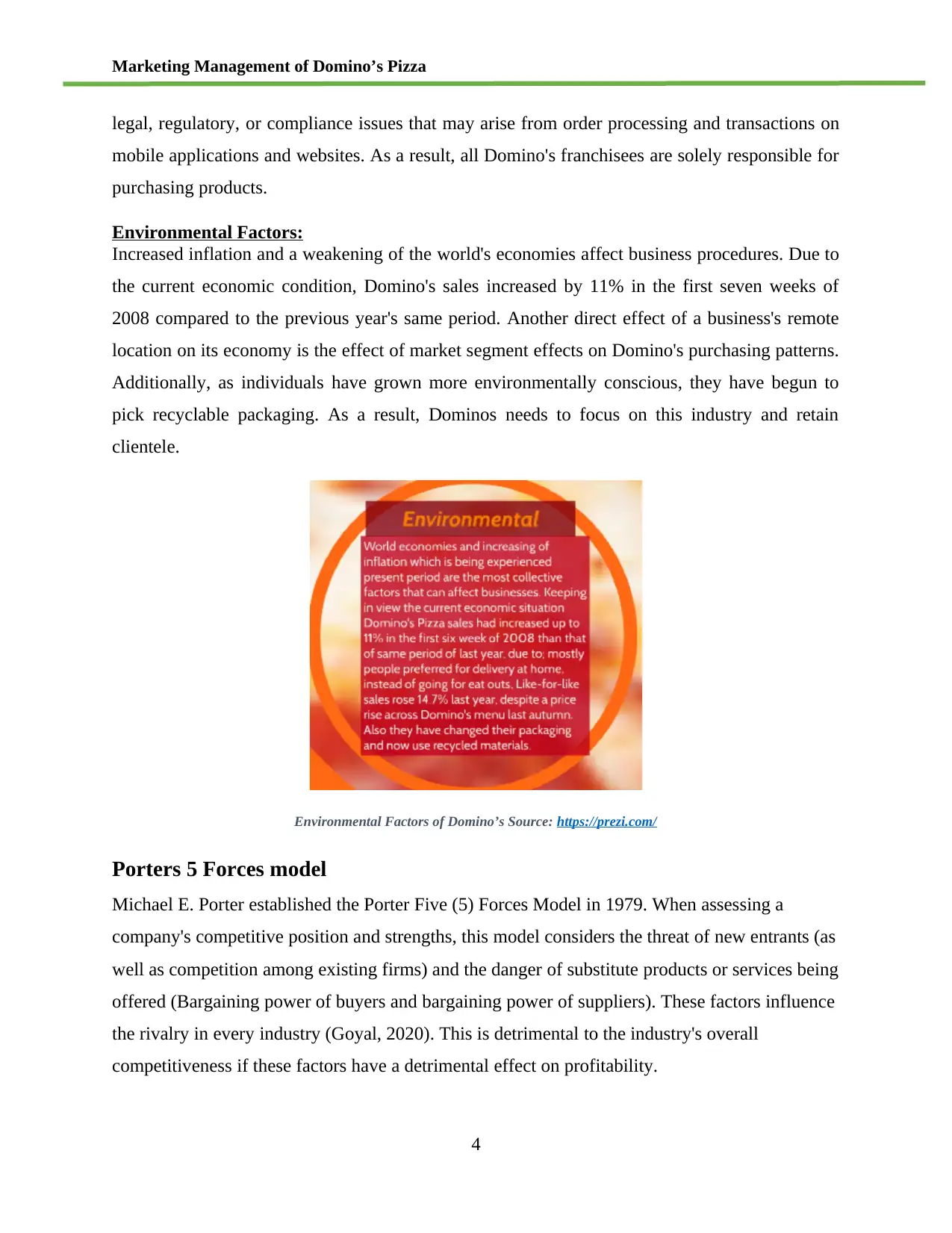
Marketing Management of Domino’s Pizza
legal, regulatory, or compliance issues that may arise from order processing and transactions on
mobile applications and websites. As a result, all Domino's franchisees are solely responsible for
purchasing products.
Environmental Factors:
Increased inflation and a weakening of the world's economies affect business procedures. Due to
the current economic condition, Domino's sales increased by 11% in the first seven weeks of
2008 compared to the previous year's same period. Another direct effect of a business's remote
location on its economy is the effect of market segment effects on Domino's purchasing patterns.
Additionally, as individuals have grown more environmentally conscious, they have begun to
pick recyclable packaging. As a result, Dominos needs to focus on this industry and retain
clientele.
Environmental Factors of Domino’s Source: https://prezi.com/
Porters 5 Forces model
Michael E. Porter established the Porter Five (5) Forces Model in 1979. When assessing a
company's competitive position and strengths, this model considers the threat of new entrants (as
well as competition among existing firms) and the danger of substitute products or services being
offered (Bargaining power of buyers and bargaining power of suppliers). These factors influence
the rivalry in every industry (Goyal, 2020). This is detrimental to the industry's overall
competitiveness if these factors have a detrimental effect on profitability.
4
legal, regulatory, or compliance issues that may arise from order processing and transactions on
mobile applications and websites. As a result, all Domino's franchisees are solely responsible for
purchasing products.
Environmental Factors:
Increased inflation and a weakening of the world's economies affect business procedures. Due to
the current economic condition, Domino's sales increased by 11% in the first seven weeks of
2008 compared to the previous year's same period. Another direct effect of a business's remote
location on its economy is the effect of market segment effects on Domino's purchasing patterns.
Additionally, as individuals have grown more environmentally conscious, they have begun to
pick recyclable packaging. As a result, Dominos needs to focus on this industry and retain
clientele.
Environmental Factors of Domino’s Source: https://prezi.com/
Porters 5 Forces model
Michael E. Porter established the Porter Five (5) Forces Model in 1979. When assessing a
company's competitive position and strengths, this model considers the threat of new entrants (as
well as competition among existing firms) and the danger of substitute products or services being
offered (Bargaining power of buyers and bargaining power of suppliers). These factors influence
the rivalry in every industry (Goyal, 2020). This is detrimental to the industry's overall
competitiveness if these factors have a detrimental effect on profitability.
4
⊘ This is a preview!⊘
Do you want full access?
Subscribe today to unlock all pages.

Trusted by 1+ million students worldwide
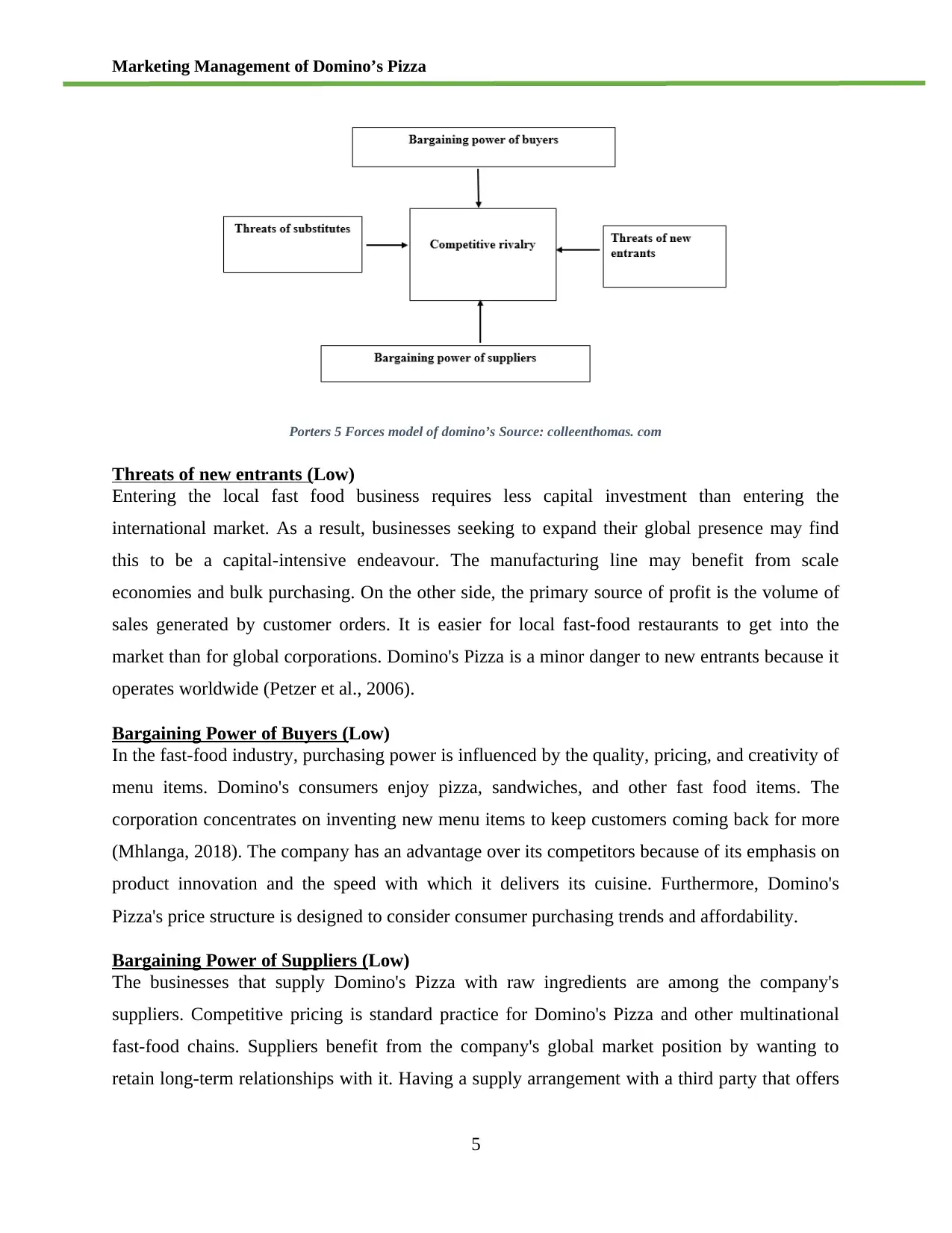
Marketing Management of Domino’s Pizza
Porters 5 Forces model of domino’s Source: colleenthomas. com
Threats of new entrants (Low)
Entering the local fast food business requires less capital investment than entering the
international market. As a result, businesses seeking to expand their global presence may find
this to be a capital-intensive endeavour. The manufacturing line may benefit from scale
economies and bulk purchasing. On the other side, the primary source of profit is the volume of
sales generated by customer orders. It is easier for local fast-food restaurants to get into the
market than for global corporations. Domino's Pizza is a minor danger to new entrants because it
operates worldwide (Petzer et al., 2006).
Bargaining Power of Buyers (Low)
In the fast-food industry, purchasing power is influenced by the quality, pricing, and creativity of
menu items. Domino's consumers enjoy pizza, sandwiches, and other fast food items. The
corporation concentrates on inventing new menu items to keep customers coming back for more
(Mhlanga, 2018). The company has an advantage over its competitors because of its emphasis on
product innovation and the speed with which it delivers its cuisine. Furthermore, Domino's
Pizza's price structure is designed to consider consumer purchasing trends and affordability.
Bargaining Power of Suppliers (Low)
The businesses that supply Domino's Pizza with raw ingredients are among the company's
suppliers. Competitive pricing is standard practice for Domino's Pizza and other multinational
fast-food chains. Suppliers benefit from the company's global market position by wanting to
retain long-term relationships with it. Having a supply arrangement with a third party that offers
5
Porters 5 Forces model of domino’s Source: colleenthomas. com
Threats of new entrants (Low)
Entering the local fast food business requires less capital investment than entering the
international market. As a result, businesses seeking to expand their global presence may find
this to be a capital-intensive endeavour. The manufacturing line may benefit from scale
economies and bulk purchasing. On the other side, the primary source of profit is the volume of
sales generated by customer orders. It is easier for local fast-food restaurants to get into the
market than for global corporations. Domino's Pizza is a minor danger to new entrants because it
operates worldwide (Petzer et al., 2006).
Bargaining Power of Buyers (Low)
In the fast-food industry, purchasing power is influenced by the quality, pricing, and creativity of
menu items. Domino's consumers enjoy pizza, sandwiches, and other fast food items. The
corporation concentrates on inventing new menu items to keep customers coming back for more
(Mhlanga, 2018). The company has an advantage over its competitors because of its emphasis on
product innovation and the speed with which it delivers its cuisine. Furthermore, Domino's
Pizza's price structure is designed to consider consumer purchasing trends and affordability.
Bargaining Power of Suppliers (Low)
The businesses that supply Domino's Pizza with raw ingredients are among the company's
suppliers. Competitive pricing is standard practice for Domino's Pizza and other multinational
fast-food chains. Suppliers benefit from the company's global market position by wanting to
retain long-term relationships with it. Having a supply arrangement with a third party that offers
5
Paraphrase This Document
Need a fresh take? Get an instant paraphrase of this document with our AI Paraphraser
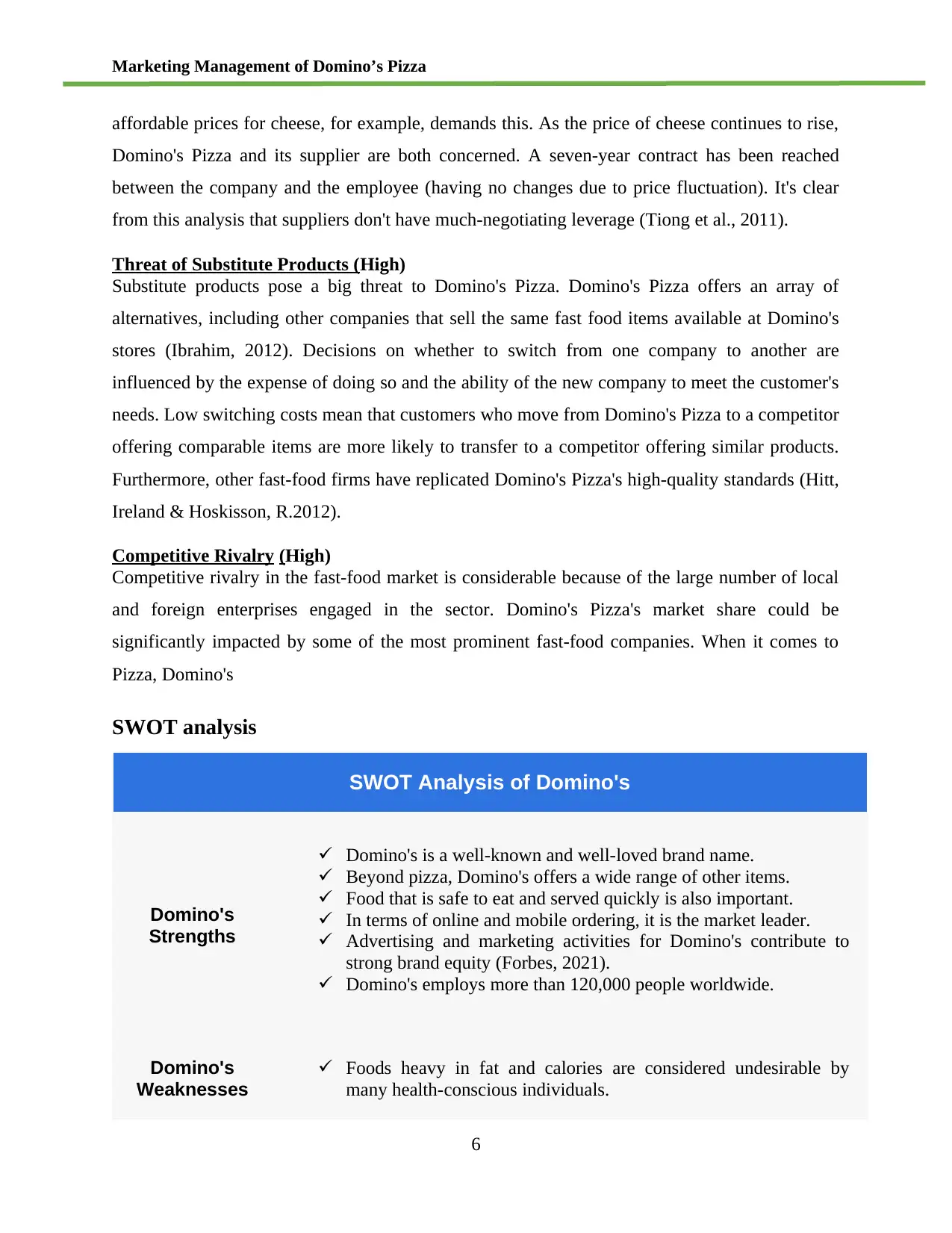
Marketing Management of Domino’s Pizza
affordable prices for cheese, for example, demands this. As the price of cheese continues to rise,
Domino's Pizza and its supplier are both concerned. A seven-year contract has been reached
between the company and the employee (having no changes due to price fluctuation). It's clear
from this analysis that suppliers don't have much-negotiating leverage (Tiong et al., 2011).
Threat of Substitute Products (High)
Substitute products pose a big threat to Domino's Pizza. Domino's Pizza offers an array of
alternatives, including other companies that sell the same fast food items available at Domino's
stores (Ibrahim, 2012). Decisions on whether to switch from one company to another are
influenced by the expense of doing so and the ability of the new company to meet the customer's
needs. Low switching costs mean that customers who move from Domino's Pizza to a competitor
offering comparable items are more likely to transfer to a competitor offering similar products.
Furthermore, other fast-food firms have replicated Domino's Pizza's high-quality standards (Hitt,
Ireland & Hoskisson, R.2012).
Competitive Rivalry (High)
Competitive rivalry in the fast-food market is considerable because of the large number of local
and foreign enterprises engaged in the sector. Domino's Pizza's market share could be
significantly impacted by some of the most prominent fast-food companies. When it comes to
Pizza, Domino's
SWOT analysis
SWOT Analysis of Domino's
Domino's
Strengths
Domino's is a well-known and well-loved brand name.
Beyond pizza, Domino's offers a wide range of other items.
Food that is safe to eat and served quickly is also important.
In terms of online and mobile ordering, it is the market leader.
Advertising and marketing activities for Domino's contribute to
strong brand equity (Forbes, 2021).
Domino's employs more than 120,000 people worldwide.
Domino's
Weaknesses
Foods heavy in fat and calories are considered undesirable by
many health-conscious individuals.
6
affordable prices for cheese, for example, demands this. As the price of cheese continues to rise,
Domino's Pizza and its supplier are both concerned. A seven-year contract has been reached
between the company and the employee (having no changes due to price fluctuation). It's clear
from this analysis that suppliers don't have much-negotiating leverage (Tiong et al., 2011).
Threat of Substitute Products (High)
Substitute products pose a big threat to Domino's Pizza. Domino's Pizza offers an array of
alternatives, including other companies that sell the same fast food items available at Domino's
stores (Ibrahim, 2012). Decisions on whether to switch from one company to another are
influenced by the expense of doing so and the ability of the new company to meet the customer's
needs. Low switching costs mean that customers who move from Domino's Pizza to a competitor
offering comparable items are more likely to transfer to a competitor offering similar products.
Furthermore, other fast-food firms have replicated Domino's Pizza's high-quality standards (Hitt,
Ireland & Hoskisson, R.2012).
Competitive Rivalry (High)
Competitive rivalry in the fast-food market is considerable because of the large number of local
and foreign enterprises engaged in the sector. Domino's Pizza's market share could be
significantly impacted by some of the most prominent fast-food companies. When it comes to
Pizza, Domino's
SWOT analysis
SWOT Analysis of Domino's
Domino's
Strengths
Domino's is a well-known and well-loved brand name.
Beyond pizza, Domino's offers a wide range of other items.
Food that is safe to eat and served quickly is also important.
In terms of online and mobile ordering, it is the market leader.
Advertising and marketing activities for Domino's contribute to
strong brand equity (Forbes, 2021).
Domino's employs more than 120,000 people worldwide.
Domino's
Weaknesses
Foods heavy in fat and calories are considered undesirable by
many health-conscious individuals.
6
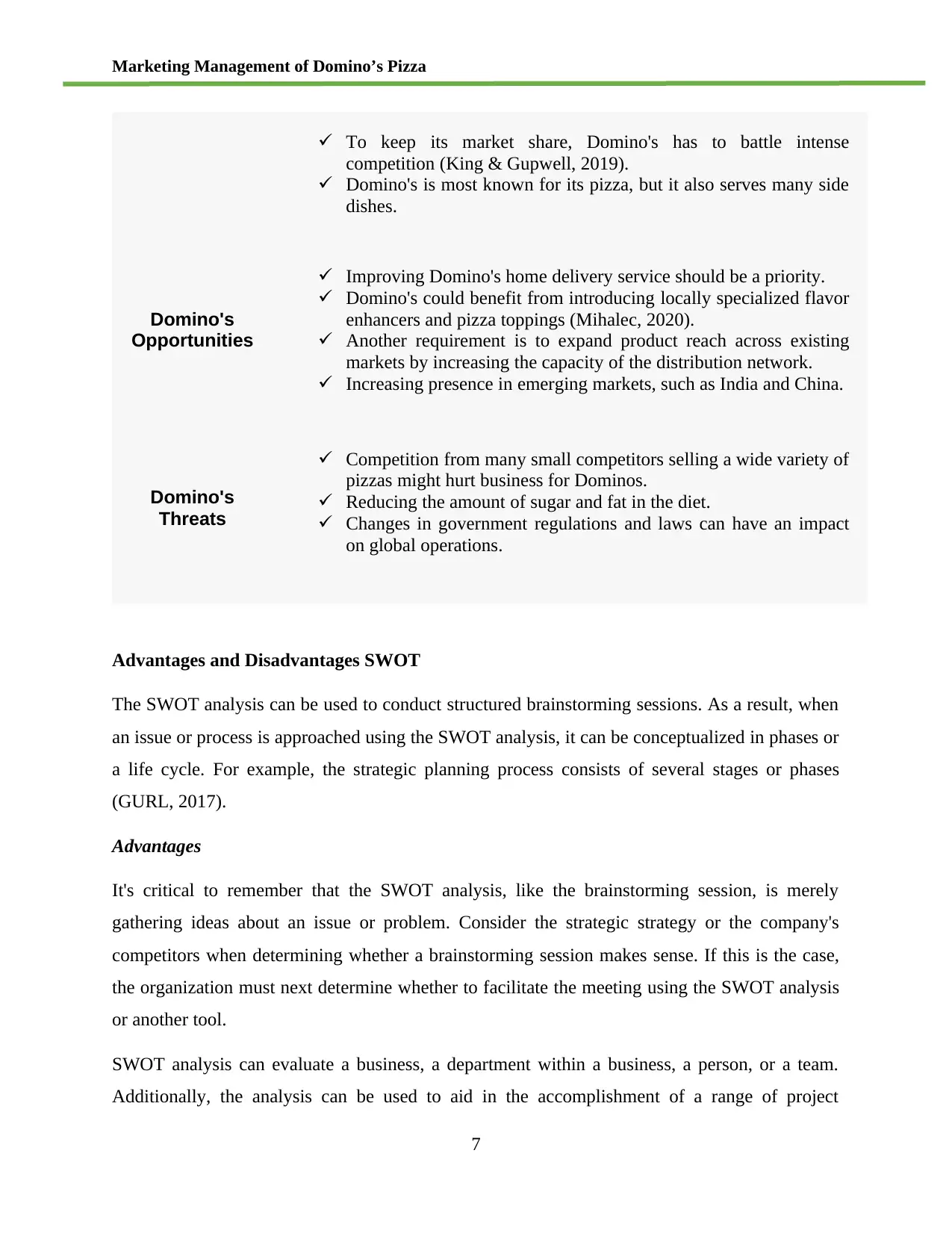
Marketing Management of Domino’s Pizza
To keep its market share, Domino's has to battle intense
competition (King & Gupwell, 2019).
Domino's is most known for its pizza, but it also serves many side
dishes.
Domino's
Opportunities
Improving Domino's home delivery service should be a priority.
Domino's could benefit from introducing locally specialized flavor
enhancers and pizza toppings (Mihalec, 2020).
Another requirement is to expand product reach across existing
markets by increasing the capacity of the distribution network.
Increasing presence in emerging markets, such as India and China.
Domino's
Threats
Competition from many small competitors selling a wide variety of
pizzas might hurt business for Dominos.
Reducing the amount of sugar and fat in the diet.
Changes in government regulations and laws can have an impact
on global operations.
Advantages and Disadvantages SWOT
The SWOT analysis can be used to conduct structured brainstorming sessions. As a result, when
an issue or process is approached using the SWOT analysis, it can be conceptualized in phases or
a life cycle. For example, the strategic planning process consists of several stages or phases
(GURL, 2017).
Advantages
It's critical to remember that the SWOT analysis, like the brainstorming session, is merely
gathering ideas about an issue or problem. Consider the strategic strategy or the company's
competitors when determining whether a brainstorming session makes sense. If this is the case,
the organization must next determine whether to facilitate the meeting using the SWOT analysis
or another tool.
SWOT analysis can evaluate a business, a department within a business, a person, or a team.
Additionally, the analysis can be used to aid in the accomplishment of a range of project
7
To keep its market share, Domino's has to battle intense
competition (King & Gupwell, 2019).
Domino's is most known for its pizza, but it also serves many side
dishes.
Domino's
Opportunities
Improving Domino's home delivery service should be a priority.
Domino's could benefit from introducing locally specialized flavor
enhancers and pizza toppings (Mihalec, 2020).
Another requirement is to expand product reach across existing
markets by increasing the capacity of the distribution network.
Increasing presence in emerging markets, such as India and China.
Domino's
Threats
Competition from many small competitors selling a wide variety of
pizzas might hurt business for Dominos.
Reducing the amount of sugar and fat in the diet.
Changes in government regulations and laws can have an impact
on global operations.
Advantages and Disadvantages SWOT
The SWOT analysis can be used to conduct structured brainstorming sessions. As a result, when
an issue or process is approached using the SWOT analysis, it can be conceptualized in phases or
a life cycle. For example, the strategic planning process consists of several stages or phases
(GURL, 2017).
Advantages
It's critical to remember that the SWOT analysis, like the brainstorming session, is merely
gathering ideas about an issue or problem. Consider the strategic strategy or the company's
competitors when determining whether a brainstorming session makes sense. If this is the case,
the organization must next determine whether to facilitate the meeting using the SWOT analysis
or another tool.
SWOT analysis can evaluate a business, a department within a business, a person, or a team.
Additionally, the analysis can be used to aid in the accomplishment of a range of project
7
⊘ This is a preview!⊘
Do you want full access?
Subscribe today to unlock all pages.

Trusted by 1+ million students worldwide
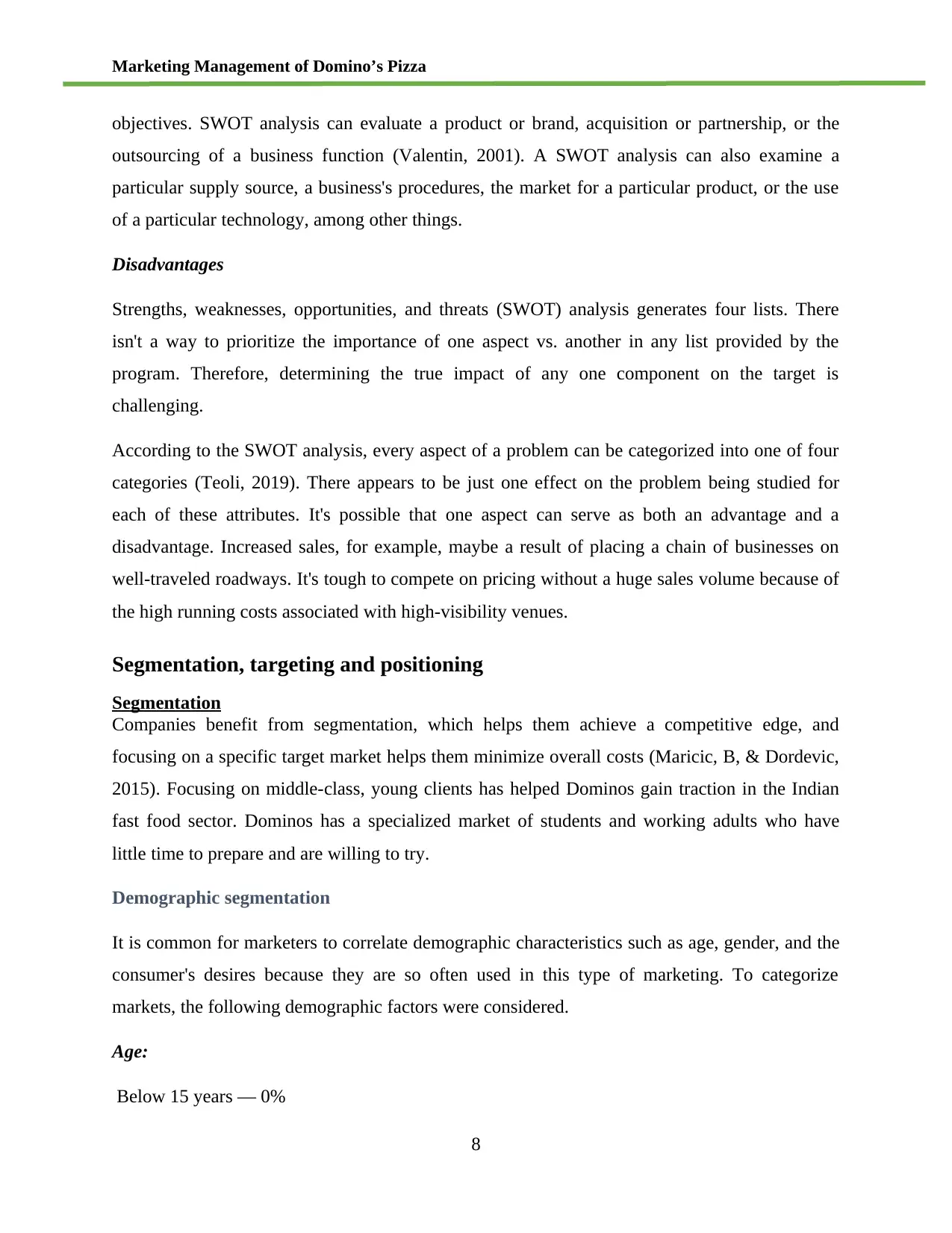
Marketing Management of Domino’s Pizza
objectives. SWOT analysis can evaluate a product or brand, acquisition or partnership, or the
outsourcing of a business function (Valentin, 2001). A SWOT analysis can also examine a
particular supply source, a business's procedures, the market for a particular product, or the use
of a particular technology, among other things.
Disadvantages
Strengths, weaknesses, opportunities, and threats (SWOT) analysis generates four lists. There
isn't a way to prioritize the importance of one aspect vs. another in any list provided by the
program. Therefore, determining the true impact of any one component on the target is
challenging.
According to the SWOT analysis, every aspect of a problem can be categorized into one of four
categories (Teoli, 2019). There appears to be just one effect on the problem being studied for
each of these attributes. It's possible that one aspect can serve as both an advantage and a
disadvantage. Increased sales, for example, maybe a result of placing a chain of businesses on
well-traveled roadways. It's tough to compete on pricing without a huge sales volume because of
the high running costs associated with high-visibility venues.
Segmentation, targeting and positioning
Segmentation
Companies benefit from segmentation, which helps them achieve a competitive edge, and
focusing on a specific target market helps them minimize overall costs (Maricic, B, & Dordevic,
2015). Focusing on middle-class, young clients has helped Dominos gain traction in the Indian
fast food sector. Dominos has a specialized market of students and working adults who have
little time to prepare and are willing to try.
Demographic segmentation
It is common for marketers to correlate demographic characteristics such as age, gender, and the
consumer's desires because they are so often used in this type of marketing. To categorize
markets, the following demographic factors were considered.
Age:
Below 15 years — 0%
8
objectives. SWOT analysis can evaluate a product or brand, acquisition or partnership, or the
outsourcing of a business function (Valentin, 2001). A SWOT analysis can also examine a
particular supply source, a business's procedures, the market for a particular product, or the use
of a particular technology, among other things.
Disadvantages
Strengths, weaknesses, opportunities, and threats (SWOT) analysis generates four lists. There
isn't a way to prioritize the importance of one aspect vs. another in any list provided by the
program. Therefore, determining the true impact of any one component on the target is
challenging.
According to the SWOT analysis, every aspect of a problem can be categorized into one of four
categories (Teoli, 2019). There appears to be just one effect on the problem being studied for
each of these attributes. It's possible that one aspect can serve as both an advantage and a
disadvantage. Increased sales, for example, maybe a result of placing a chain of businesses on
well-traveled roadways. It's tough to compete on pricing without a huge sales volume because of
the high running costs associated with high-visibility venues.
Segmentation, targeting and positioning
Segmentation
Companies benefit from segmentation, which helps them achieve a competitive edge, and
focusing on a specific target market helps them minimize overall costs (Maricic, B, & Dordevic,
2015). Focusing on middle-class, young clients has helped Dominos gain traction in the Indian
fast food sector. Dominos has a specialized market of students and working adults who have
little time to prepare and are willing to try.
Demographic segmentation
It is common for marketers to correlate demographic characteristics such as age, gender, and the
consumer's desires because they are so often used in this type of marketing. To categorize
markets, the following demographic factors were considered.
Age:
Below 15 years — 0%
8
Paraphrase This Document
Need a fresh take? Get an instant paraphrase of this document with our AI Paraphraser
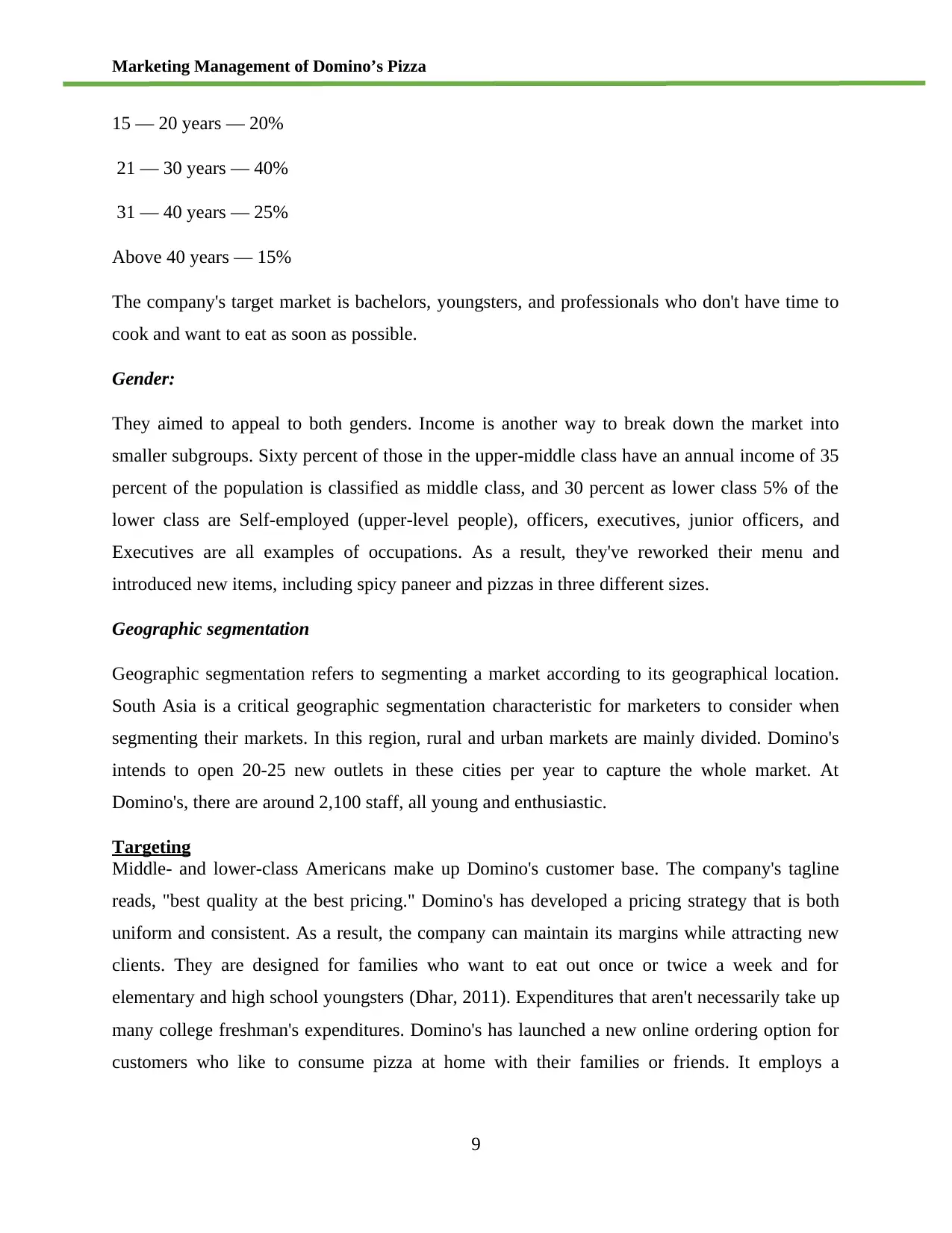
Marketing Management of Domino’s Pizza
15 — 20 years — 20%
21 — 30 years — 40%
31 — 40 years — 25%
Above 40 years — 15%
The company's target market is bachelors, youngsters, and professionals who don't have time to
cook and want to eat as soon as possible.
Gender:
They aimed to appeal to both genders. Income is another way to break down the market into
smaller subgroups. Sixty percent of those in the upper-middle class have an annual income of 35
percent of the population is classified as middle class, and 30 percent as lower class 5% of the
lower class are Self-employed (upper-level people), officers, executives, junior officers, and
Executives are all examples of occupations. As a result, they've reworked their menu and
introduced new items, including spicy paneer and pizzas in three different sizes.
Geographic segmentation
Geographic segmentation refers to segmenting a market according to its geographical location.
South Asia is a critical geographic segmentation characteristic for marketers to consider when
segmenting their markets. In this region, rural and urban markets are mainly divided. Domino's
intends to open 20-25 new outlets in these cities per year to capture the whole market. At
Domino's, there are around 2,100 staff, all young and enthusiastic.
Targeting
Middle- and lower-class Americans make up Domino's customer base. The company's tagline
reads, "best quality at the best pricing." Domino's has developed a pricing strategy that is both
uniform and consistent. As a result, the company can maintain its margins while attracting new
clients. They are designed for families who want to eat out once or twice a week and for
elementary and high school youngsters (Dhar, 2011). Expenditures that aren't necessarily take up
many college freshman's expenditures. Domino's has launched a new online ordering option for
customers who like to consume pizza at home with their families or friends. It employs a
9
15 — 20 years — 20%
21 — 30 years — 40%
31 — 40 years — 25%
Above 40 years — 15%
The company's target market is bachelors, youngsters, and professionals who don't have time to
cook and want to eat as soon as possible.
Gender:
They aimed to appeal to both genders. Income is another way to break down the market into
smaller subgroups. Sixty percent of those in the upper-middle class have an annual income of 35
percent of the population is classified as middle class, and 30 percent as lower class 5% of the
lower class are Self-employed (upper-level people), officers, executives, junior officers, and
Executives are all examples of occupations. As a result, they've reworked their menu and
introduced new items, including spicy paneer and pizzas in three different sizes.
Geographic segmentation
Geographic segmentation refers to segmenting a market according to its geographical location.
South Asia is a critical geographic segmentation characteristic for marketers to consider when
segmenting their markets. In this region, rural and urban markets are mainly divided. Domino's
intends to open 20-25 new outlets in these cities per year to capture the whole market. At
Domino's, there are around 2,100 staff, all young and enthusiastic.
Targeting
Middle- and lower-class Americans make up Domino's customer base. The company's tagline
reads, "best quality at the best pricing." Domino's has developed a pricing strategy that is both
uniform and consistent. As a result, the company can maintain its margins while attracting new
clients. They are designed for families who want to eat out once or twice a week and for
elementary and high school youngsters (Dhar, 2011). Expenditures that aren't necessarily take up
many college freshman's expenditures. Domino's has launched a new online ordering option for
customers who like to consume pizza at home with their families or friends. It employs a
9
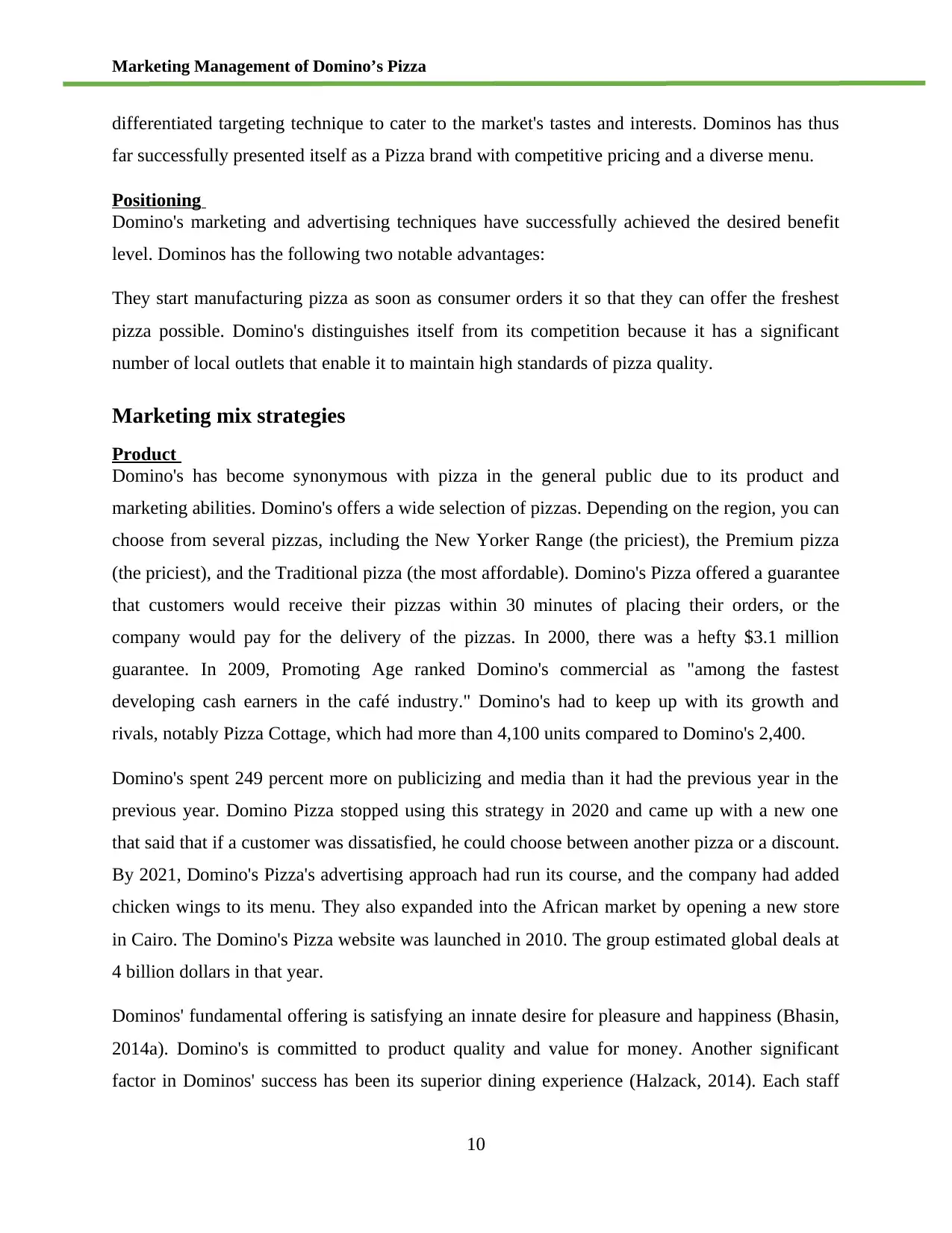
Marketing Management of Domino’s Pizza
differentiated targeting technique to cater to the market's tastes and interests. Dominos has thus
far successfully presented itself as a Pizza brand with competitive pricing and a diverse menu.
Positioning
Domino's marketing and advertising techniques have successfully achieved the desired benefit
level. Dominos has the following two notable advantages:
They start manufacturing pizza as soon as consumer orders it so that they can offer the freshest
pizza possible. Domino's distinguishes itself from its competition because it has a significant
number of local outlets that enable it to maintain high standards of pizza quality.
Marketing mix strategies
Product
Domino's has become synonymous with pizza in the general public due to its product and
marketing abilities. Domino's offers a wide selection of pizzas. Depending on the region, you can
choose from several pizzas, including the New Yorker Range (the priciest), the Premium pizza
(the priciest), and the Traditional pizza (the most affordable). Domino's Pizza offered a guarantee
that customers would receive their pizzas within 30 minutes of placing their orders, or the
company would pay for the delivery of the pizzas. In 2000, there was a hefty $3.1 million
guarantee. In 2009, Promoting Age ranked Domino's commercial as "among the fastest
developing cash earners in the café industry." Domino's had to keep up with its growth and
rivals, notably Pizza Cottage, which had more than 4,100 units compared to Domino's 2,400.
Domino's spent 249 percent more on publicizing and media than it had the previous year in the
previous year. Domino Pizza stopped using this strategy in 2020 and came up with a new one
that said that if a customer was dissatisfied, he could choose between another pizza or a discount.
By 2021, Domino's Pizza's advertising approach had run its course, and the company had added
chicken wings to its menu. They also expanded into the African market by opening a new store
in Cairo. The Domino's Pizza website was launched in 2010. The group estimated global deals at
4 billion dollars in that year.
Dominos' fundamental offering is satisfying an innate desire for pleasure and happiness (Bhasin,
2014a). Domino's is committed to product quality and value for money. Another significant
factor in Dominos' success has been its superior dining experience (Halzack, 2014). Each staff
10
differentiated targeting technique to cater to the market's tastes and interests. Dominos has thus
far successfully presented itself as a Pizza brand with competitive pricing and a diverse menu.
Positioning
Domino's marketing and advertising techniques have successfully achieved the desired benefit
level. Dominos has the following two notable advantages:
They start manufacturing pizza as soon as consumer orders it so that they can offer the freshest
pizza possible. Domino's distinguishes itself from its competition because it has a significant
number of local outlets that enable it to maintain high standards of pizza quality.
Marketing mix strategies
Product
Domino's has become synonymous with pizza in the general public due to its product and
marketing abilities. Domino's offers a wide selection of pizzas. Depending on the region, you can
choose from several pizzas, including the New Yorker Range (the priciest), the Premium pizza
(the priciest), and the Traditional pizza (the most affordable). Domino's Pizza offered a guarantee
that customers would receive their pizzas within 30 minutes of placing their orders, or the
company would pay for the delivery of the pizzas. In 2000, there was a hefty $3.1 million
guarantee. In 2009, Promoting Age ranked Domino's commercial as "among the fastest
developing cash earners in the café industry." Domino's had to keep up with its growth and
rivals, notably Pizza Cottage, which had more than 4,100 units compared to Domino's 2,400.
Domino's spent 249 percent more on publicizing and media than it had the previous year in the
previous year. Domino Pizza stopped using this strategy in 2020 and came up with a new one
that said that if a customer was dissatisfied, he could choose between another pizza or a discount.
By 2021, Domino's Pizza's advertising approach had run its course, and the company had added
chicken wings to its menu. They also expanded into the African market by opening a new store
in Cairo. The Domino's Pizza website was launched in 2010. The group estimated global deals at
4 billion dollars in that year.
Dominos' fundamental offering is satisfying an innate desire for pleasure and happiness (Bhasin,
2014a). Domino's is committed to product quality and value for money. Another significant
factor in Dominos' success has been its superior dining experience (Halzack, 2014). Each staff
10
⊘ This is a preview!⊘
Do you want full access?
Subscribe today to unlock all pages.

Trusted by 1+ million students worldwide
1 out of 20
Related Documents
Your All-in-One AI-Powered Toolkit for Academic Success.
+13062052269
info@desklib.com
Available 24*7 on WhatsApp / Email
![[object Object]](/_next/static/media/star-bottom.7253800d.svg)
Unlock your academic potential
Copyright © 2020–2025 A2Z Services. All Rights Reserved. Developed and managed by ZUCOL.





